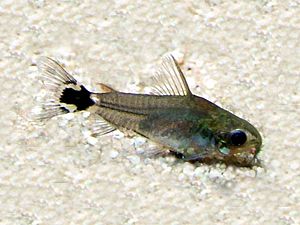Dwarf corydoras facts for kids
Quick facts for kids Dwarf corydoras |
|
|---|---|
 |
|
| Scientific classification | |
| Synonyms | |
|
The dwarf corydoras is a tiny, peaceful fish. People also call it the dwarf catfish, tail spot pygmy catfish, or micro catfish. Its scientific name is Corydoras hastatus. This fish lives in warm, fresh water in South America. You can find it in the Amazon River and Paraguay River areas. These areas include countries like Argentina, Bolivia, and Brazil. The name hastatus means "with a spear." This refers to the spearhead-like mark on its tail.
Contents
What Does the Dwarf Corydoras Look Like?
The dwarf corydoras has a body that is longer than most other Corydoras fish. Its body is a see-through white or olive color. It has a thin dark stripe along its sides. This stripe goes from behind its gill cover to the start of its tail. Its belly is whitish.
There is a white crescent shape at the base of its tail. This shape goes around a black spot. This fish usually grows up to 1.4 inches (3.5 cm) long. But most often, they are about 1.0 inch (2.5 cm) long. Male dwarf corydoras are smaller and thinner than females. They also have a more pointed dorsal fin.
Where Do Dwarf Corydoras Live?
Dwarf corydoras live in warm, tropical places. They like water with a pH between 6.0 and 8.0. The water hardness should be 5 to 19 dGH. They prefer temperatures from 68 to 82 degrees Fahrenheit (20 to 28 °C). You can find them in ponds and rivers. They eat small worms, tiny crustaceans, insects, and plant bits. They are common in the Paraguay River and Amazon River basins.
How Do Dwarf Corydoras Behave?
C. hastatus fish like to live among plants. They are a schooling species, meaning they like to swim together in groups. Unlike most Corydoras fish, they prefer to swim in the middle of the water. They spend most of their time in areas with lots of plants. When they need to rest, they rest on plant leaves.
Other Corydoras fish that also swim in mid-water include C. habrosus and C. pygmaeus. The dwarf corydoras moves its fins very quickly to stay in place in a current. This is especially true for its pectoral fins. These fast movements make the fish seem "nervous" compared to other fish. Sometimes, C. hastatus even swims with small characins.
Dwarf Corydoras Life Cycle and Reproduction
Female dwarf corydoras lay their eggs in thick plants. The adult fish do not guard their eggs. The female holds one egg between her pelvic fins. The male then fertilizes it for about 30 seconds. After that, the female swims to a good spot and sticks the egg there. The pair repeats this process every three minutes. They do this for one to two hours, with short breaks.
A female can lay about 7 to 15 eggs in one day. They will lay eggs for three to four days in a row. A single female might lay 30 to 60 eggs in total during this time. The eggs hatch in three to nine days. The baby fish, called fry, are about 6 mm long when they hatch. They are mostly see-through, but some might have spots. In two months, the fry grow to about 18 mm long. They become adults in six to eight months.
Keeping Dwarf Corydoras in an Aquarium
The dwarf corydoras is a popular fish for home aquariums. Because they are so small, you can keep them in a small tank. A 5-gallon (20 liter) tank is enough for a small group. Since they are schooling fish, you should always keep at least six of them together. They are good fish for a community tank with other peaceful fish. Good tankmates include tetras, rasboras, and danios. Do not keep them with fish that are too aggressive. They can also help clean fry tanks.
Aquarium Setup
Your aquarium should be clean and have good air flow. It should also have many plants for hiding spots. These fish like a moderate current from a filter. The water should be slightly alkaline, around a pH of 7.6. The temperature should be between 24° and 29 °C. Even though they usually swim in the middle of the water, you should have fine gravel or sand at the bottom. They will sometimes dig in it.
Feeding Your Dwarf Corydoras
These fish will eat food in the middle of the water or on the bottom. They will eat from a plant leaf, a flat rock, or the tank bottom. They eat most types of fish food. This includes freeze-dried, flake, and frozen foods. They especially love live foods.
Breeding Dwarf Corydoras in an Aquarium
Breeding dwarf corydoras in an aquarium is similar to breeding other Corydoras species. You can use a small tank for breeding, even 2.5 gallons (10 L). But a 5-gallon (20 L) tank is better. Use aged water, a sponge filter, and some plants. You should feed the fish lots of live foods. Good choices are Tubifex worms and whiteworms. This will make the females look much plumper. Since C. hastatus can breed as a group, you can prepare the whole group at once. For best results, have at least two males for every female.
When the fish are ready to breed, you can start the process by adding cooler water. During spawning, the fish will not eat much. But they will look for food right after they finish. They usually attach their eggs to plants in the aquarium. If there are not enough plants, they might use the sides of the tank. When the fry hatch, you can feed them newly hatched brine shrimp or microworms. The parent fish might be ready to breed again in a few weeks.
See also
 In Spanish: Corydoras hastatus para niños
In Spanish: Corydoras hastatus para niños
- List of freshwater aquarium fish species

